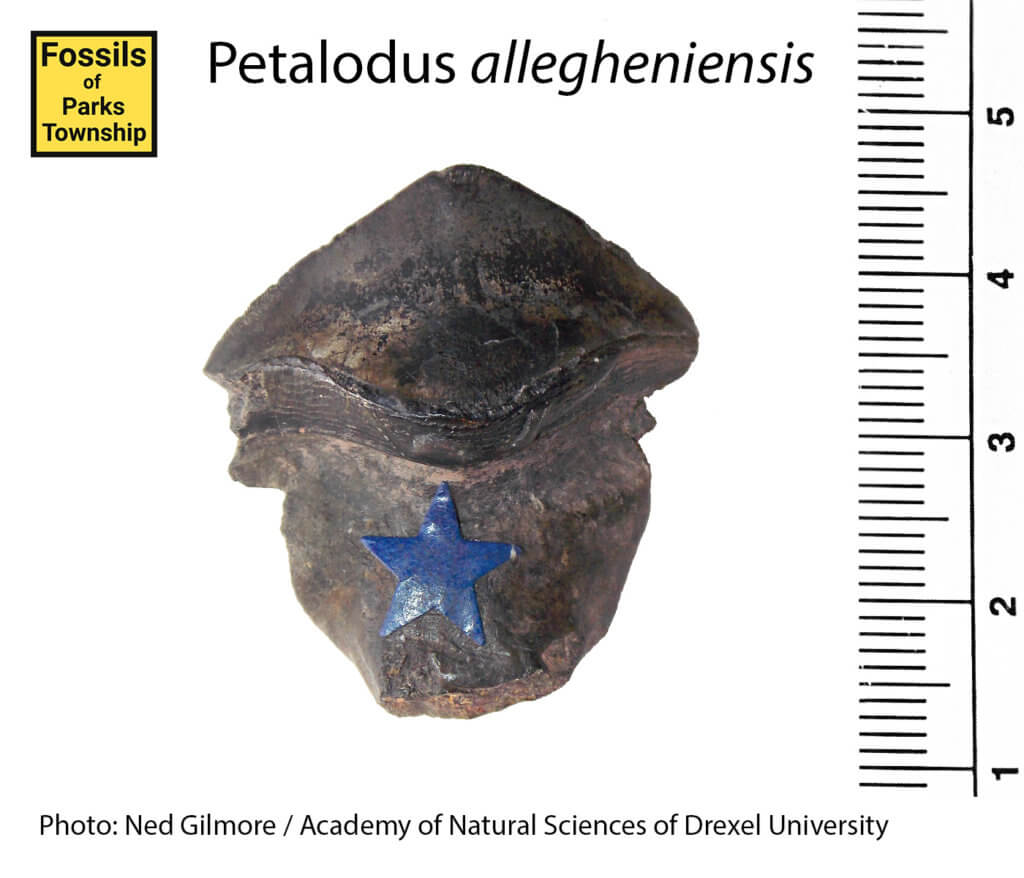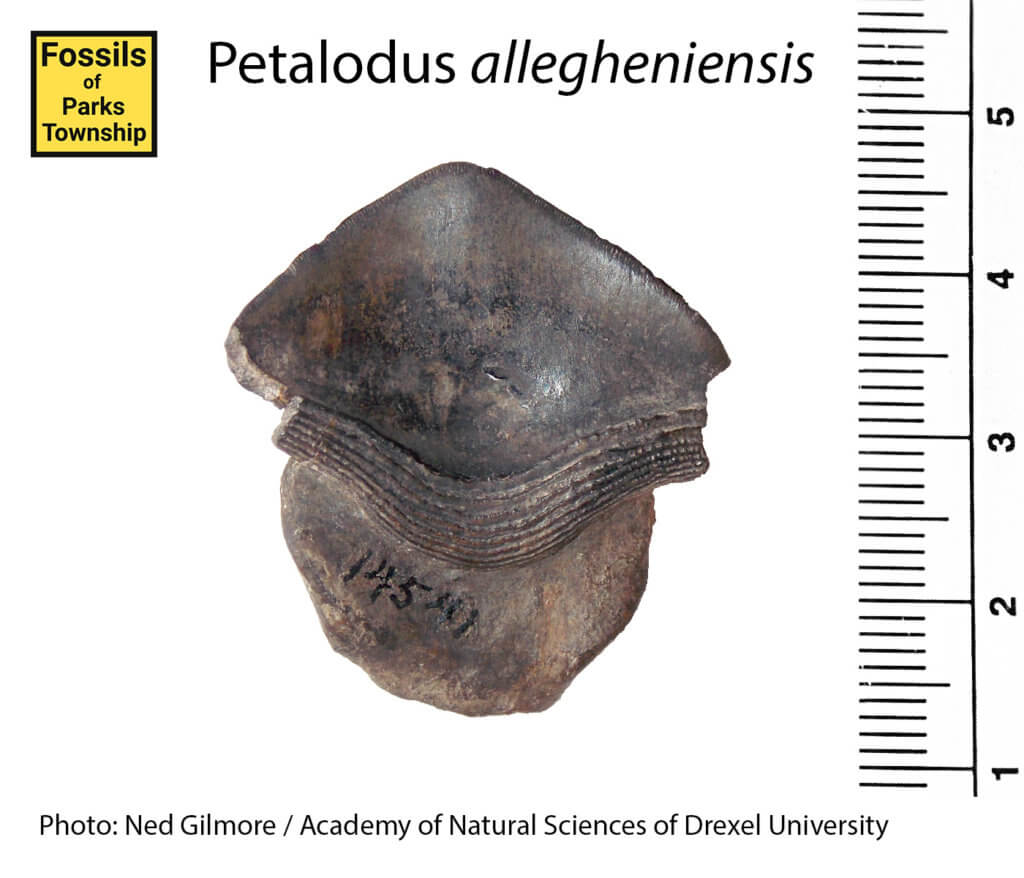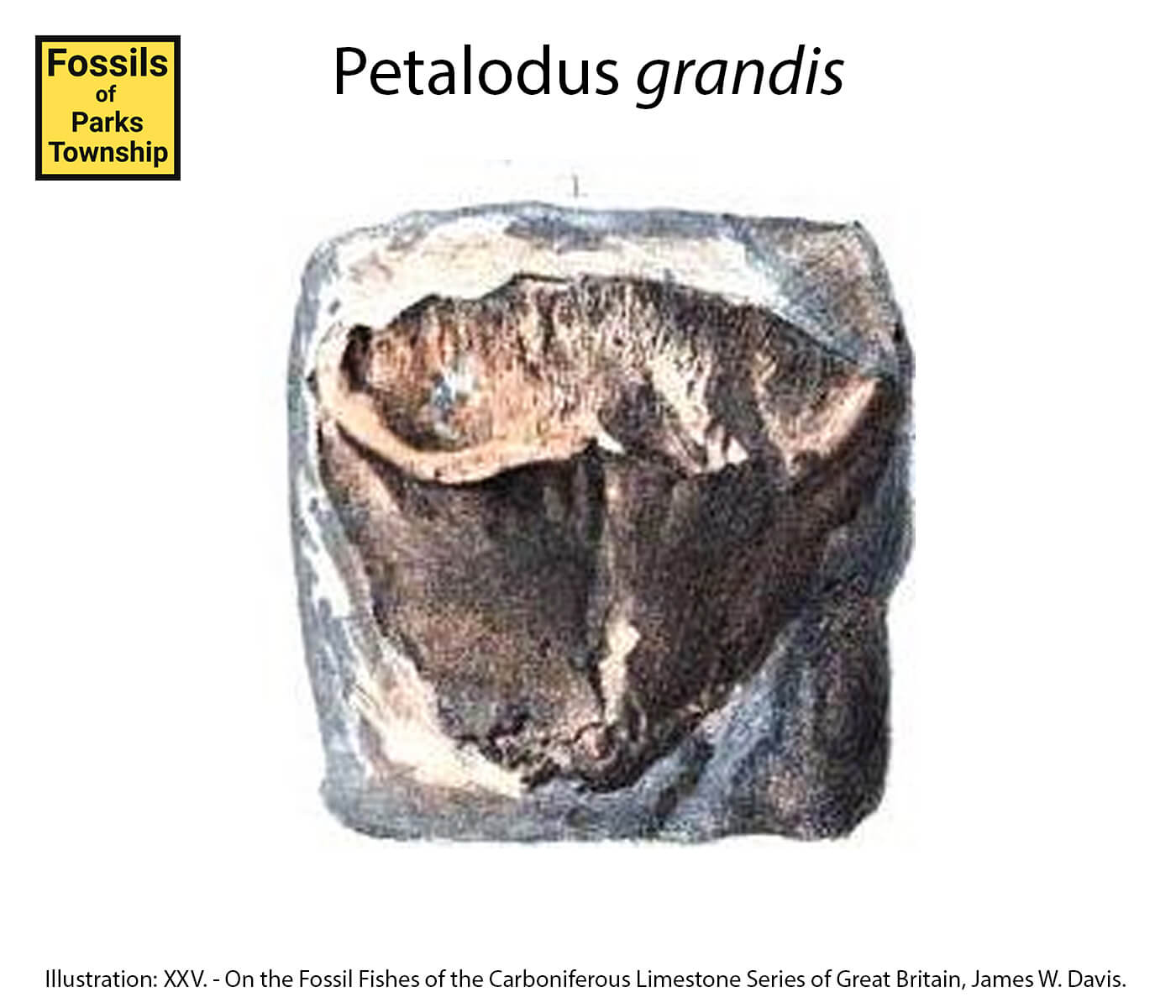Petalodus is by far the most interesting genus of vertebrate fossils easily found in Parks Township. These fossil “sharks” had jaws full of cutting serrated teeth but are not “sharks” as we know them today. Sharks are in the same class, the Chondrichthyes, defined as “fishes having a cartilaginous skeleton”.
The bodies did not preserve well with skeletons made of cartilage. Despite the volume of dental specimens found within the class, the genus is only known from its teeth. Fossilized body or jaw remains of the genus remain undiscovered anywhere worldwide. All current reconstructions of the creature are based on the body remains of the sibling genera found within its class, the Chondrichthyes.
More about Petalodus ohioensis here
Petalodus Taxonomy
| Kingdom | Animalia |
| Phylum | Chordata |
| Class | Chondrichthyes |
| Order | †Petalodontiformes |
| Family | †Petalodontidae |
| Genus | †Petalodus |
Specimens from Parks Township
In 2019, I recovered four different teeth from the local limestone layer. A year later, I found ten more specimens, one from Pine Creek Limestone. All are the species Petalodus ohioensis, the default designation for the genus in North America.
| Catalog ID | Specimen Name | Crown Height | Crown Width |
|---|---|---|---|
| CG-0015 | Petalodus I | 6mm | 23mm |
| CG-0016 | Petalodus II | 9.5mm | 24mm* |
| CG-0029 | Petalodus III | 8mm | 28mm* |
| CG-0027 | Petalodus IV | 10.5mm | ** |
| CG-0034 | Petalodus V | 14mm | 27mm* |
| CG-0038 | Petalodus VI | 5.5mm*** | ** |
| CG-0045 | Petalodus VII | 10mm | 25mm |
| CG-0047 | Petalodus VIII | 13mm | 31mm |
| CG-0048 | Petalodus IX | **** | ** |
| CG-0055 | Petalodus X | 11mm† | 28mm |
| CG-0058 | Petalodus XI | 8mm† | 27mm |
| CG-0070 | Petalodus XII | **** | ** |
| CG-0087 | Petalodus XIII | 9mm | 23mm |
| CG-0102 | Petalodus XIV | Coming Soon | Coming Soon |
| CG-0107 | Petalodus XV | Coming Soon | Coming Soon |
* – Measured based on symmetry. One side broken/obscured.
** – Unable to measure, both sides were broken.
*** – From the top of the distal crown tongue.
**** – Unable to measure, crown broken.
† – Measured from the labial side.
Petalodus Tooth Anatomy
Below, you will find three views of a Petalodus Tooth. Shown here are lingual, lateral, and labial views. The lingual is the tooth’s side facing inwards towards the tongue. The labial is the side that faces the outside of the mouth. The crown is convex as it faces outside of the mouth.
The teeth of the genus are homodont, which means that all teeth have the same morphology. Teeth toward the back appear flatter in cutting-edge profile, while ones toward the front are taller. The side profile is sigmoid in shape, or more simply, an S shape.
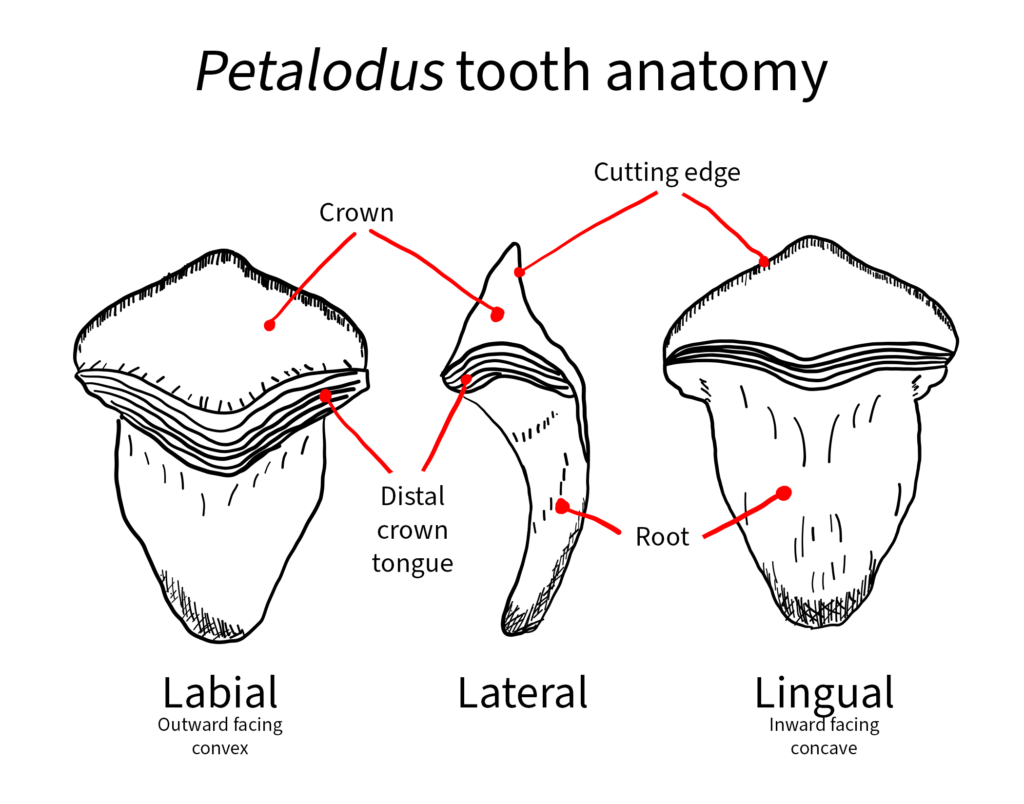
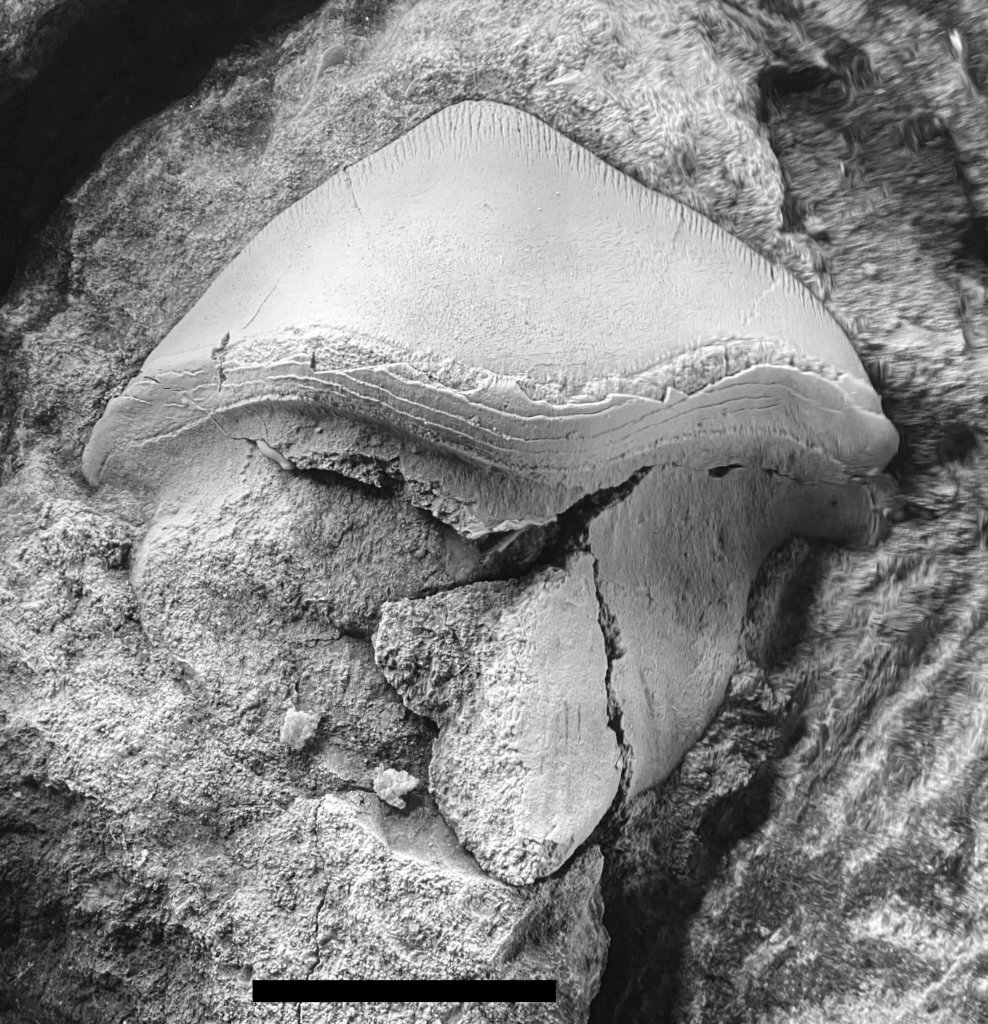
Named Petalodus Species
Sixteen (16) named species are listed in the online Paleobiological database (2021). However, more than 30 are in existence (Harper 2016). The majority of species were named in the 1800s, but just a few, one or two (Harper 2016) species, were named in the 1900s.
| Genus | Species | Year Described |
|---|---|---|
| Petalodus | acuminatus | 1836 (Agassiz) |
| Petalodus | allegheniensis | 1856 (Leidy) |
| Petalodus | arcuatus | 1870 (St. John) |
| Petalodus | curtus | 1870 (Newberry and Worthen) |
| Petalodus | davisii | 1889 (Woodward) |
| Petalodus | flabellula | 1889 (Woodward) |
| Petalodus | grandis | 1883 (Davis) |
| Petalodus | hastingsiae | 1840 (Owen) |
| Petalodus | hybridus | 1875 (St. John and Worthen) |
| Petalodus | jewetti | 1957 (Miller) |
| Petalodus | knappi | 1879 (Newberry) |
| Petalodus | linearis | 1838 (Agassiz) |
| Petalodus | linguifer | 1866 (Newberry and Worthen) |
| Petalodus | ohioensis | 1853 (Safford) |
| Petalodus | proximus | 1875 (St. John and Worthen) |
| Petalodus | sagittatus | 1843 (Agassiz) |
Why so many different species?
One of the most difficult things to figure out concerning Petalodus is how newly named species in the past correlate with different parts of the animal’s mouth morphology. When single specimens were first found, the difference between one and another could be quite striking. There are two typical arrangements. Those with a high crown and ones with a lower flat crown. These differences were the justification for many new species. Several new species were also designated based on geological and geographical differences in location.

The two teeth on Plate 1 above greatly differ in crown height and appearance. In the late 1800s, morphometric differences were common enough to result in the naming of two different species.
Petalodus Holotype Photographs
I am currently collecting holotype photographs. A type of a species is a specimen. A type of a genus is a species. The most prominent of several variations of types is the holotype. Aside from holotypes, more designations exist. In searching for holotypes of Petalodus, these situations arise and need to be situated.
Type Designation Descriptions
| Holotype | The representative specimen in which to define the species. Typically these are the specimen in which the species was first defined. |
| Paratype | When the holotype is defined alongside other specimens in the same description, these specimens are Paratypes. |
| Allotype | Used to designate a specimen of the opposite sex of the holotype specimen. This specimen is from the group of paratypes. Also used if the specimen shows features not visible on the holotype. |
| Neotype | If the Holotype is lost or destroyed or not specified in the original description of a species, then a neotype specimen may be selected. |
| Syntype | One of many specimens originally described when a holotype isn’t selected. Typically it is best practice to later define a best-in-class specimen, which is called the Lectotype. |
| Lectotype | A specimen that is selected to serve as the single type specimen from a set of Syntypes. |
| Paralectotype | Once a Lectotype is defined, the remaining syntypes are re-designated as paralectotypes. |
| Hapantotype | When the type species specimen is two or more that represent different stages of life. A juvenile and adult for instance of a related specimen. |
| Iconotype | If a new species is designed from an illustration of a specimen, then the illustration is the iconotype. This does not appear to be in use in paleontology. |
Petalodus allegheniensis
Described by Leidy in 1856, P. allegheniensis is often described as a junior synonym to P. ohioensis. Hay questioned the validity of P. ohioensis in writing as a senior synonym in 1895, but later in 1902, he listed it as such. As mentioned below, Hay later sent a high-quality cast of P. ohioensis to the Field Museum in Chicago, likely having examined it and making the determination.
This specimen was collected at the head of inclined plane No. 3 of the old Portage Railroad, in Blair County, Pennsylvania. This locality correlates with the Brush Creek limestone, which is located within the Glenshaw Formation. Digging the inclines that would carry railroad cars over the mountains in what is now known as Allegheny Portage Railroad National Historic Site, exposed many layers of rock. While digging out space for buildings for inclined plane No. 3, an engineer happened upon this specimen. It now resides as specimen ANSP 14541 at the Academy of Natural Sciences of Drexel University, in Philadelphia, PA, USA.
Original Description for P. allegheniensis
This species of Petalodus is established upon the specimen of a tooth, which Mr. Timothy Conrad borrowed from the cabinet of Charles A. Poulson, Esq., for mv inspection. It was presented to the latter gentleman by Townsend Ward, Esq., who, in a note, observes, it was given to him ” by the engineer of the stationary engine at the head of inclined plane number 3 of the old portage railroad,” which crossed the Alleghany [sic] Mountains from Hollidaysburg, in Blair County, Pennsylvania. Mr. Ward further states, “it was obtained from a stratum about one foot thick, black, carboniferous, and calcareous, which was exposed by the excavation for the buildings to accommodate the stationary engine.”
Joseph Leidy, 1856
Petalodus ohioensis
Described by Safford in 1853, the cast of the holotype of Petalodus ohioensis resides in the Yale Peabody Museum in Connecticut. The catalog number is YPM 2861. It comes from Yale University as they publish their digital collection catalog online. The tooth that was photographed is a cast of the original. I believe the original is currently lost.
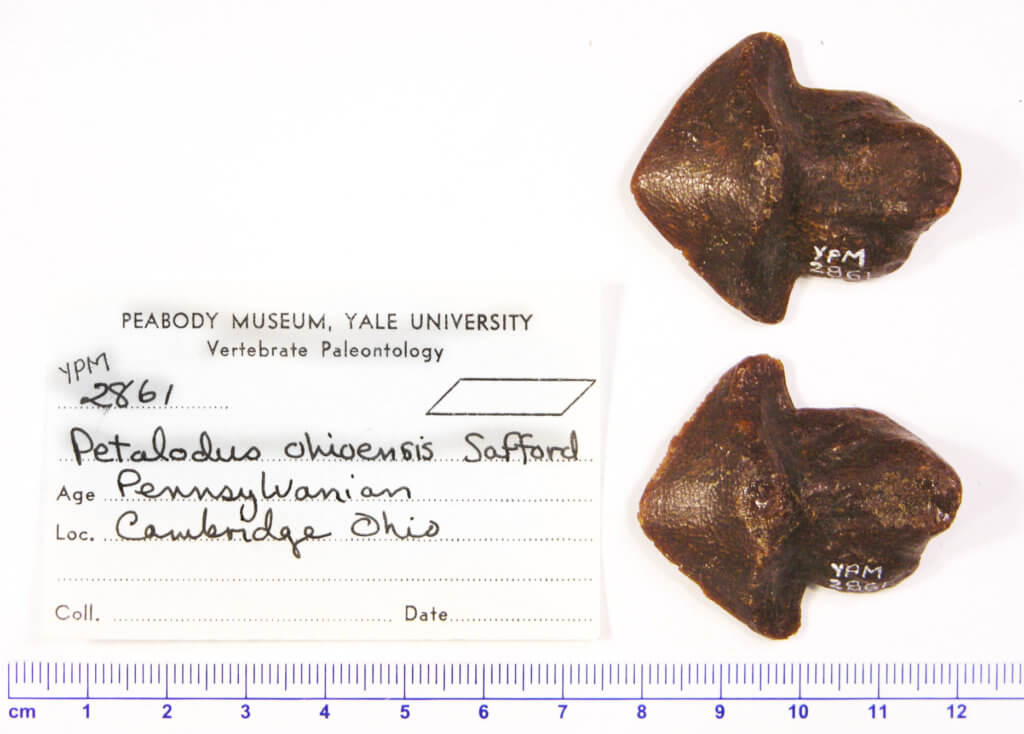
In July of 2020, I was made aware of a much better cast discovered by Wayne Itano and Kenneth Carpenter through correspondence with the Field Museum of Chicago. Specimen FMNH PF 673. This specimen is a set of three casts. One of the labial, one of the lingual, and a cast of the whole. They are of much higher resolution than the ones that reside at Yale. O.P. Hay had sent them to the museum in 1896. William Simpson is the Vertebrate Collections Manager there and provided photographs to the researchers.
J. M. Safford, the original describer of Petalodus ohioensis, was still working as a professor up until 1900. It’s very possible he sent these casts to Hay in 1895. Hay described P. securinger in 1895 and likely requested the specimen for comparison.
Petalodus acuminatus
This species was originally described in 1836 by Louis Agassiz, a Swiss geologist and biologist. The holotype is specimen MHNN-FOS 171, currently in the collections of the Muséum d’histoire naturelle de Neuchâtel in Switzerland. SM E 4291 is listed as a holotype and identified as P. acuminatus; however, it is the holotype of P. rhombus. Eventually, P. rhombus was synonymized with P. acuminatus.
The specimen appears to be a little more than half of the full tooth. The center of the crown consists of a piece of enamel that is adhered to the matrix. A cutting-edge impression can be seen on the holotype.
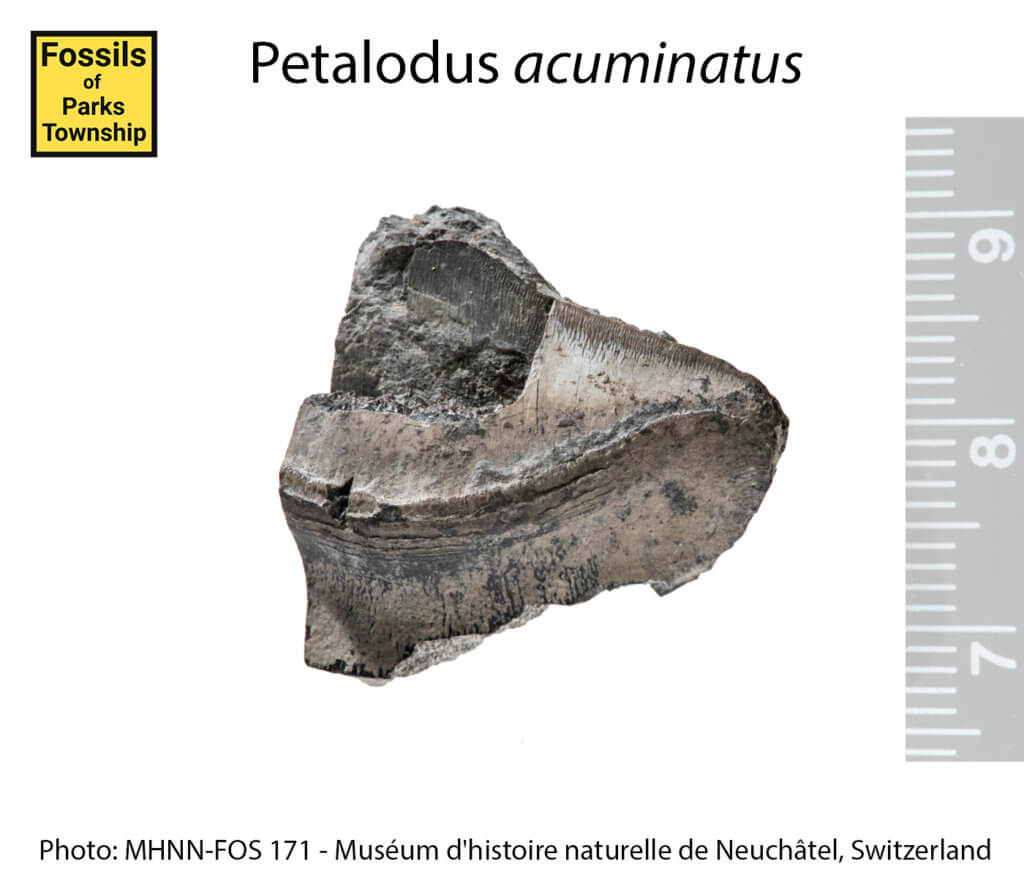
Petalodus rhombus
P. rhombus is a legacy species that has been replaced with P. acuminatus. The holotype of P. rhombus is specimen SM E 4291 housed in the Sedgwick Museum of Earth Sciences at the University of Cambridge. As part of the BG3D Type Fossils project, the specimen photo is the best I’ll likely get. It was later designated as a junior synonym of P. acuminatus. McCoy originally described this specimen as Petalodus rhombus in 1848, a new species.
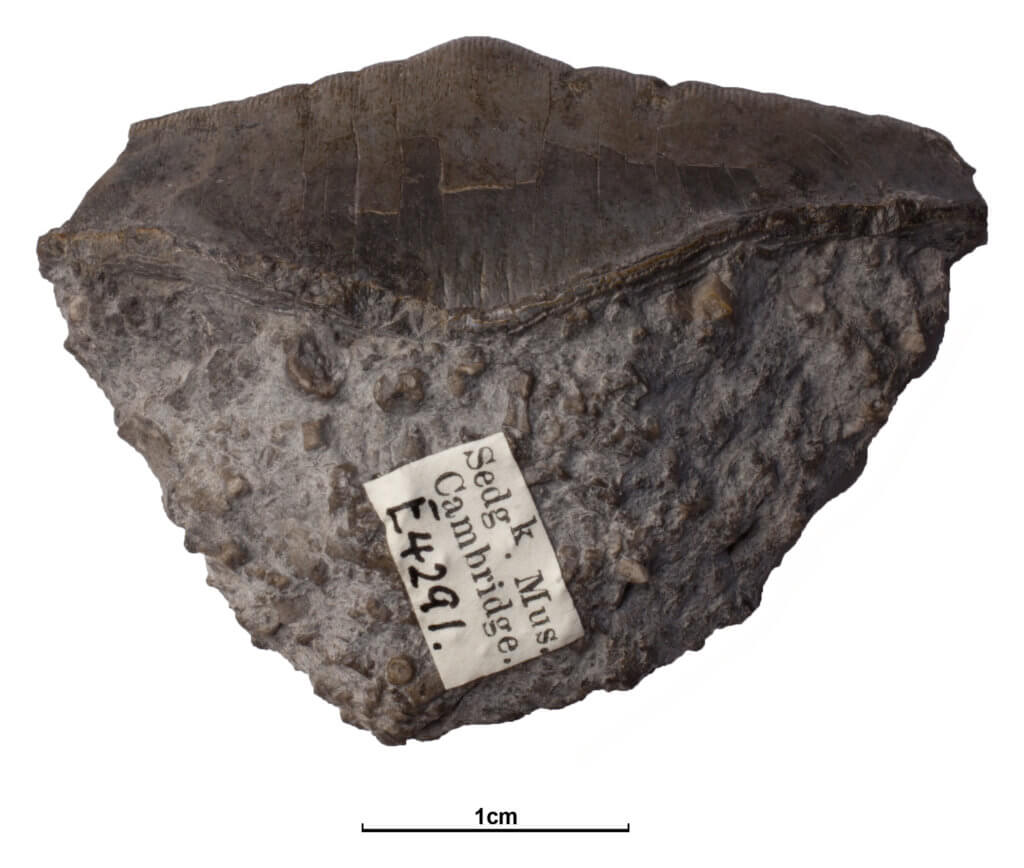


Petalodus curtus
First described in 1870 from a specimen in Illinois. The original plate illustration from his description is shown below. I am still searching for the holotype of this species, which is likely what is illustrated below.
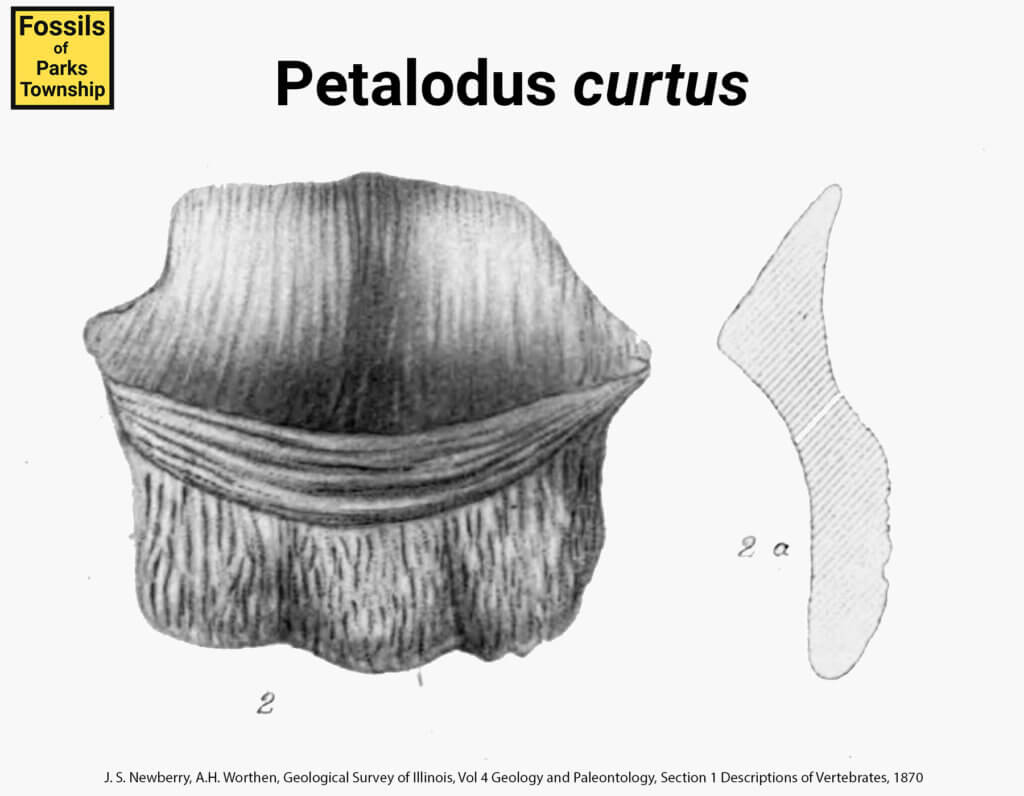
TEETH of moderate size, thin and light in crown and root; crown broadly arched, twice as wide as high, concavo-convex laterally and vertically ; superior margin serrated or roughened by the termini of the calcigerous tubes ; anterior face of crown without imbricating enamel folds, half as high as posterior face; posterior face elliptical in outline, basal enamel folds 5-6, broad and strong ; root relatively short and thin, on posterior face two-thirds the height of the crown, in breadth two-thirds that of the crown, sides nearly straight, bottom arched and somewhat three-lobed, strongly beveled off so as to form a blunt edge on the anterior and longer side.
J. S. Newberry, A.H. Worthen, Geological Survey of Illinois, Vol 4 Geology and Paleontology, Section 1 Descriptions of Vertebrates, 1870.
In general aspect this tooth resembles most P. linguifer, N. and W., from the Chester limestone, but it is thinner, and has a much shorter root, of which the lower edge is characteristically beveled. There is no other species for which it is likely to be mistaken.
Formation and locality : Keokuk limestone; Otter creek, Jersey county, Illinois.
Petalodus grandis
The tooth this species was described from was said to be 2.5 inches across. I believe an inch from Dublin in 1883 is probably the same as an inch in the United States today. It was named a new species by Davis based on its large size.
The described specimen was given an identification number and I am currently attempting to obtain current specimen photography.

Petalodus hastingsii
The tooth described by Sir Richard Owen in 1840 was provided by Sir Philip Egerton. Owen goes on to describe the tooth as having a thin layer of dense enamel, with a smooth shining surface. The holotype does exist, along with a neotype. They are NHMUK PV P613 (Holotype) and NHMUK PV P75414 in the Natural History Museum, London. We currently do not have the photos, so for now the illustrations will do.
One important fact to note is that the illustration is mirrored from the actual specimen. The specimen consists of only 30-40% of the original crown.
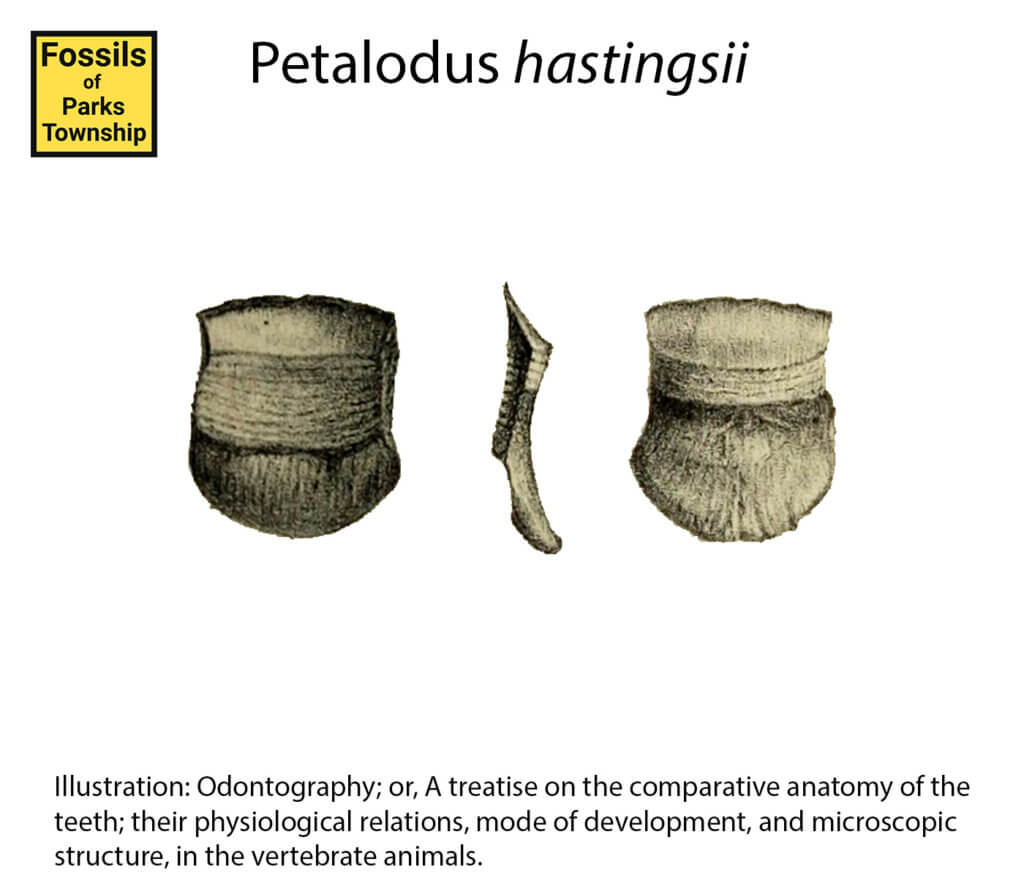
Petalodus hybridus
Described in 1875 by St. John and Worthen, this specimen came from the collection of Sir William Cornelius Van Horne. Van Horne once served as president of the Canadian Railroad Company, and later was knighted. The specimen was originally considered to be P. linguifer, and P. curtus. The authors state that the tooth may be an intermediate evolution piece stuck between the two species. It was under this assumption and its uniqueness that it should be named a new species. The fossil collection of Sir William was eventually transferred to the University of Chicago. We are still searching for the specimens.
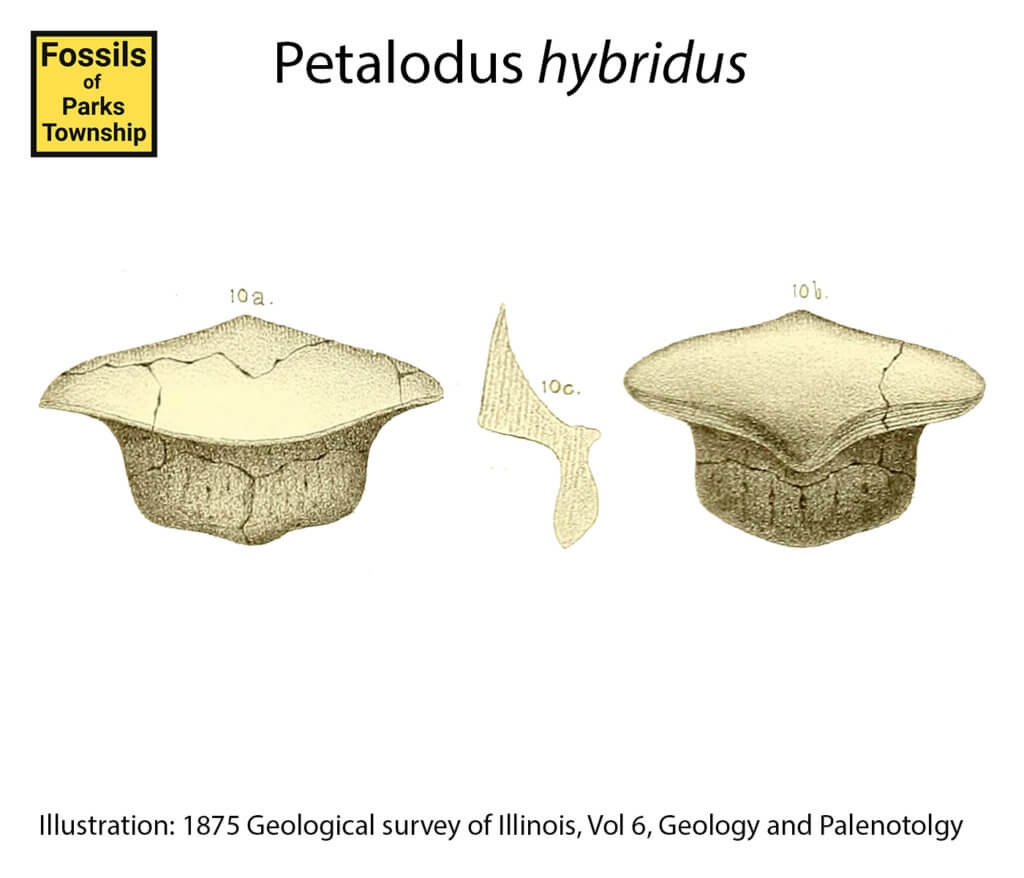
Petalodus jewetti
The holotype from this species comes from the University of Kansas Biodiversity Institute, Division of Vertebrate Paleontology. This specimen was first described by Halsey W. Miller (Jr) in 1957. The specimen catalog ID is KUVP 6672. It appears to have been glued back together in several places. Photos, as described in the original, appear to have the same silhouette.
The described specimen was originally found in October 1956, by John Mark Jewett. It was the first Petalodus tooth ever recorded as found in the Pennsylvanian rocks of Kansas. It was found in what was called the Plattsmouth limestone, Oread formation, Virgilian, upper Pennsylvanian, in a quarry in northwestern Franklin County, Kansas. The anterior crown face height was measured at 25mm while the width is 40mm. The posterior crown face height is 35mm.
Halsey W. Miller’s Arguments
Miller argued that the tooth’s morphometric distinctions and its occurrence in an area geographically separated from other species warranted a name of a new species. Miller was aware that teeth from different parts of the jaw could indeed be different but held that it would be for certain until someone finds a Petalodus jaw with embedded teeth.
A. J. Robb III (2003), considers P. jewetti to be a junior synonym of P. ohioensis, but he cited the same precautions as Miller did. Miller was also keen to mention that many species of the genus have been erroneously given unique species names for the same reasons as Robb, but still named this a new species based on a combination of morphology and geography.
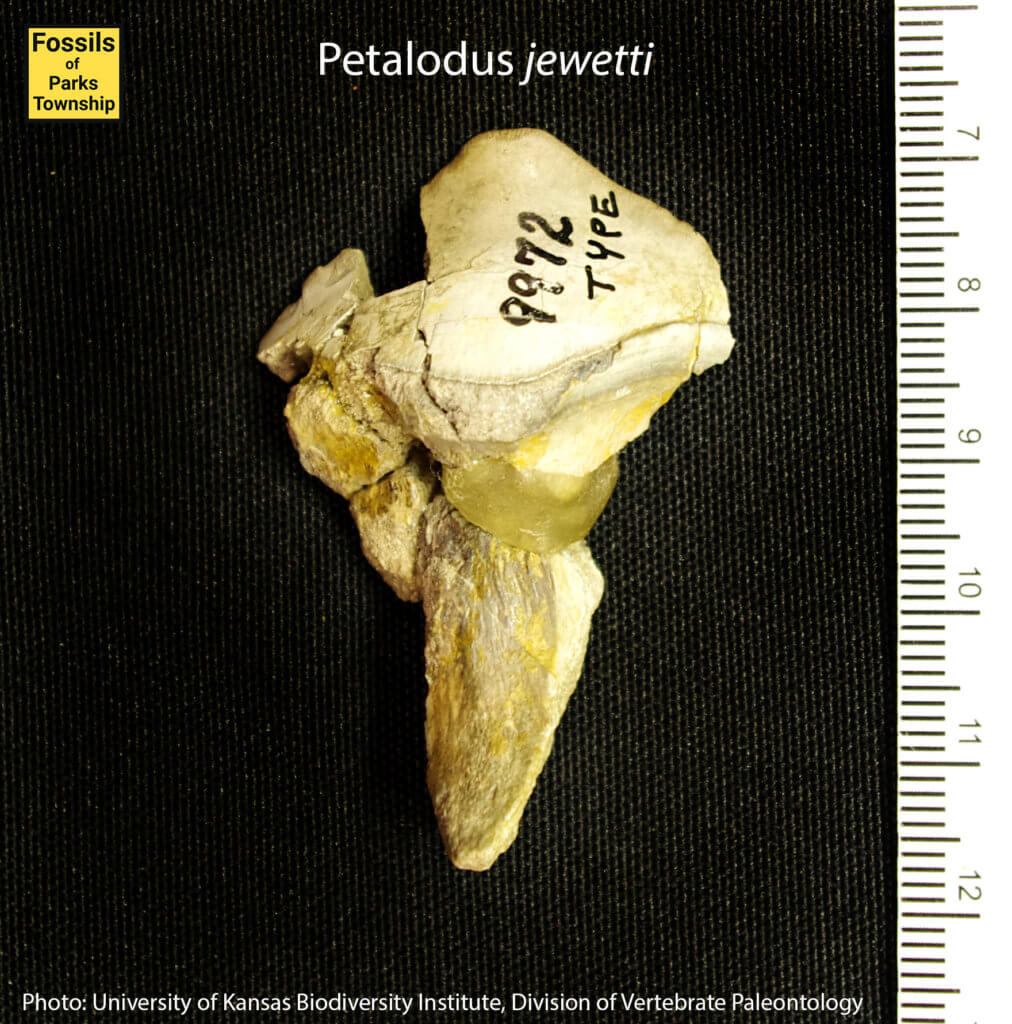

Petalodus linearis
Of all the teeth I have researched and examined via photographs, this species highly likely does not belong to the genus Petalodus. Louis Agassiz observed that these teeth were very wide, specifically six times longer than they were wide. There was a mix of teeth in the collection, originally described and illustrated as Psammodus Linearis by Agassiz. One of the syntypes is a rounded top specimen that doesn’t have the classic spade shape of Petalodus teeth. The rest are present as very long teeth. The illustration is shown below.
The longest of these teeth are six times longer than wide;
Louis Agassiz
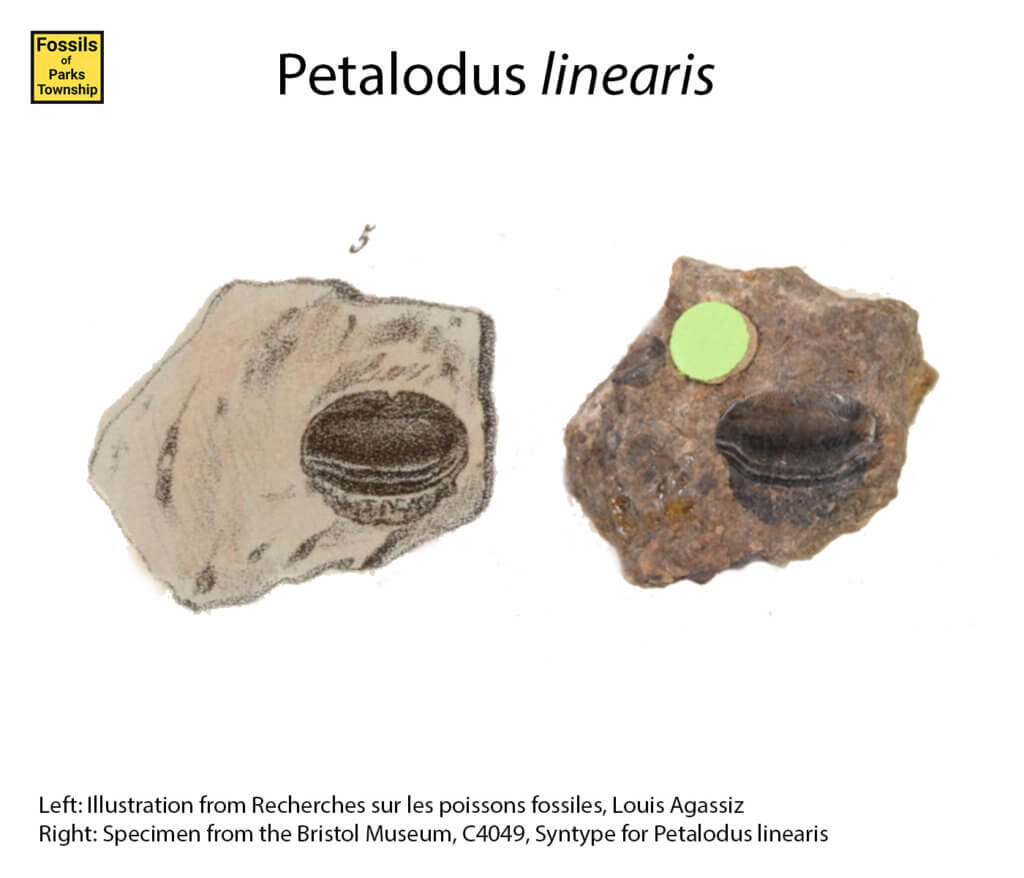
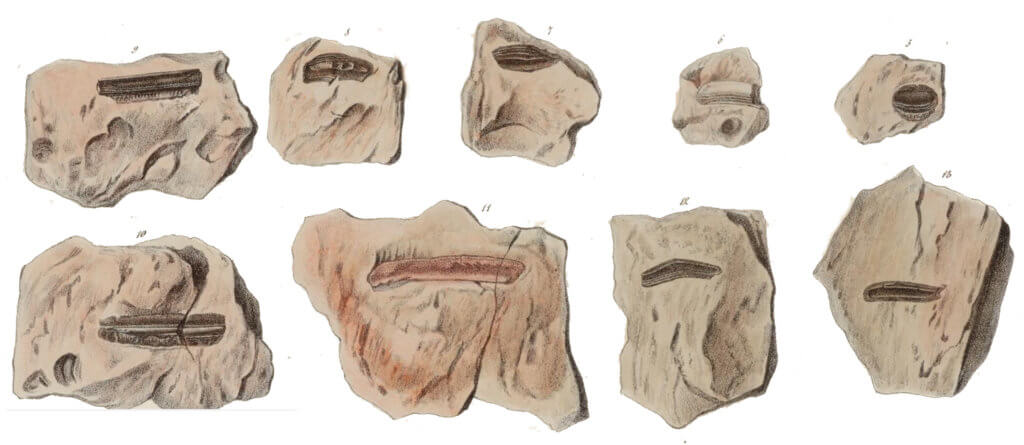
Petalodus linguifer
The type specimen, X-521, comes from the Prairie Research Institute Center for Paleontology at the University of Illinois. There are two other specimens, VPF-199 and VPF-201, at the Museum of Comparative Zoology at Harvard University. The first illustrated specimen below was described as a perfect specimen from Pope county.


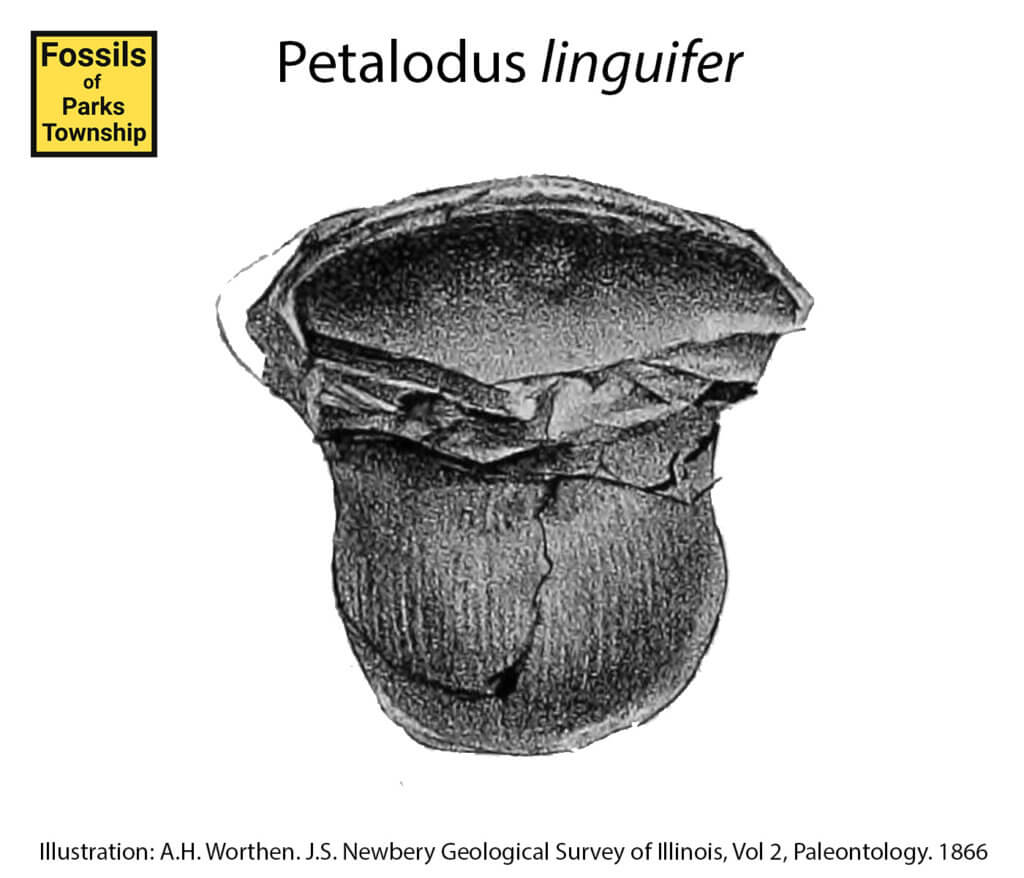
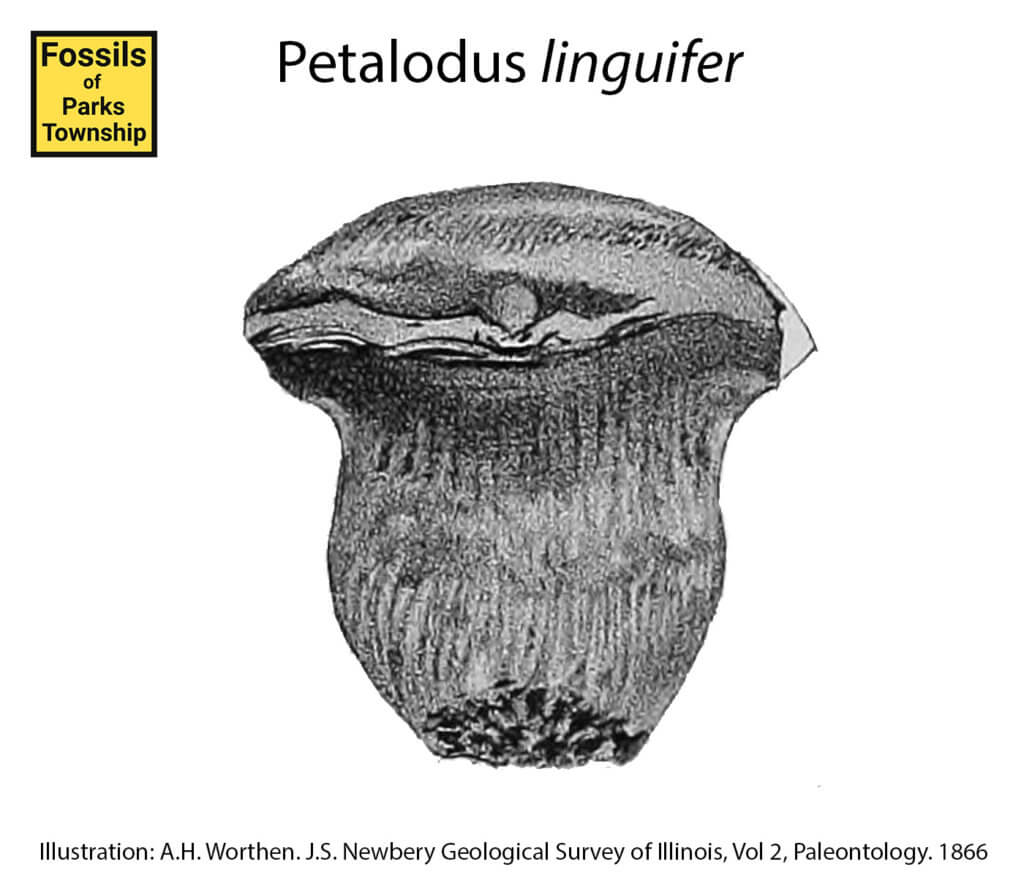
Petalodus proximus
In 1875 this was described alongside P. hybridus. This tooth was compared to P. allegheniensis, however, its uniqueness designed it as a new species as well. Dr. Leidy also apparently provided two of the original specimens of P. allegheniensis to which to compare this specimen. So the duo had more to go on than simply illustrations. The following is part of their description.
These fragments exhibit a uniformity of characters which has led provisionally to their recognition as a distinct form. From Petalodus Alleghaniensis, Leidy, with which they are associated, they are distinguished by the regularly arched crest, the comparatively horizontal direction of the basal border of the concave face, relatively low convex face, and apparently short, broadly rounded base, which is produced downward in nearly the same vertical plane as the convex crown-face, comparatively slight antero-posterior diameter, and about two-thirds the lateral diameter of the crown.
St. John and Worthen, 1875 Geological Survey of Illinois, Vol 6, Geology and Paleontology

Petalodus sagittatus
Originally grouped with the genus Chomatodus, Agassiz wrote in his Recherhes sur les poissons fossiles 1833-1843 (Research of the fossil fish) that his Chomatodus acuminatus is now part of a new genus Petalodus from M. Owen. He said it now belongs to another family, other than that of Cestraciontes, because of its sharp teeth. Agassiz then listed species of the new genus, Petalodus. Agassiz named the following species: Hastingsiae (now corrected as Hastingsii), psittacinus, laevissimus, rectus, radicans, marginalis, and sagittatus.
This species was illustrated in a book by Frederick McCoy, in 1855 as a specimen in the Geological Museum of the University of Cambridge.
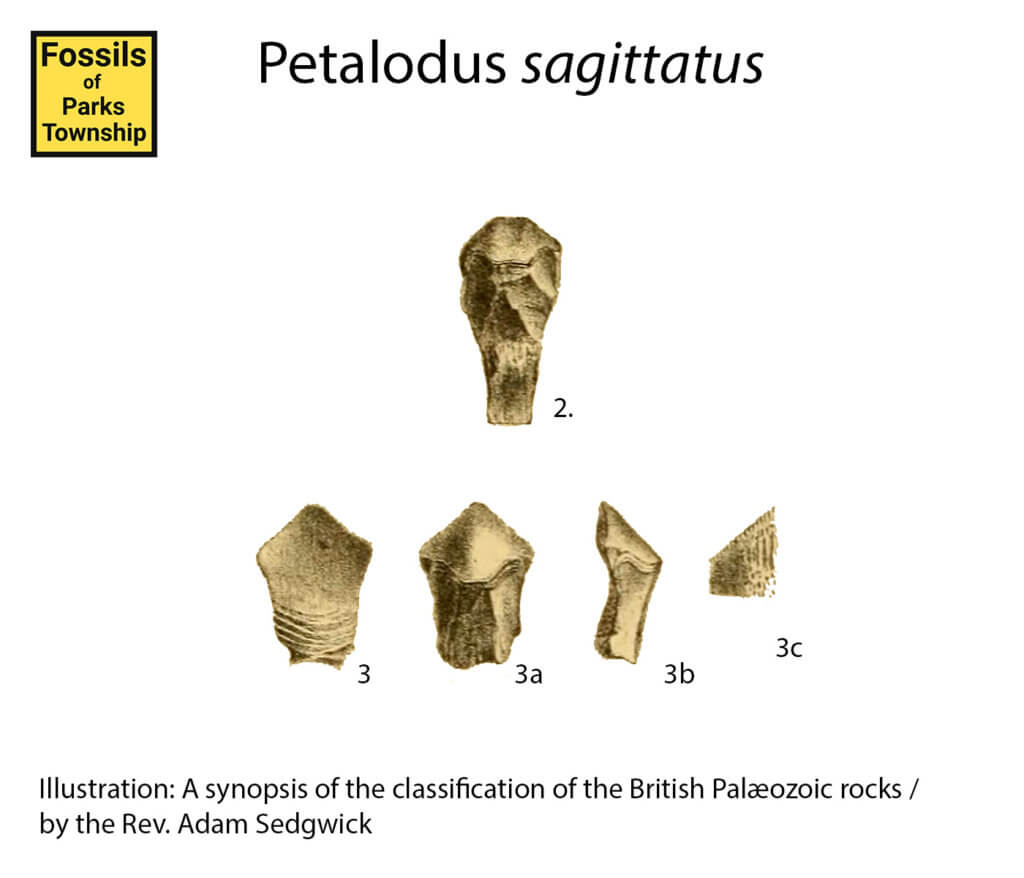
Digital References
The following are website references for information used in this article.
- Fossils of Parks Township – Catalog – Petalodus
- Fossilworks – Taxon Page
- YPM 2861 Collections Page – Yale Peabody Museum of Natural History
- Google Books – The annals and magazine of natural history, zoology, botany and geology: incorporating the journal of botany, Volume 2, Taylor & Francis, 1848
- GB3D Type Fossils – SM E 4291 – Fossil specimen : SM E 4291 – Holotype
References
- Agassiz, L. 1838. Recherches Sur Les Poissons Fossiles. Tome III (livr. 11). Imprimérie de Petitpierre, Neuchatel 73-14
- Bruner, J.C., 1992, A catalogue of type specimens of fossil fishes in the Field Museum of Natural History: Fieldiana Geology, v. 23, pp. 1–54.
- Harper, J.A., 2018, Reflections on Petalodus, a Common Late Paleozoic “Shark”1 Tooth Found in Western Pennsylvania’s Rocks, Pennsylvania Geology V. 48 No 2, pp. 3-11
- Hay, O.P., 1895, Description of a new species of Petalodus (P. Securiger) from the Carboniferous of Illinois, The Journal of Geology, pp. 561-564
- Hay, O.P. 1902 Bibliography and catalogue of the fossil Vertebrata of North America. U.S. Geological Survey, Bulletin 179, 868 p.
- Itano, W., Carpenter, K, 2020, High-quality Casts of the Missing Holotype of Petalodus ohioensis Safford 1853 (Chondrichthyes, Petalodontidae) at the Field Museum of Natural History and their Bearing on the Validity and Priority of the Species, Geology of the Intermountain West, V. 7, pp. 197-203
- Itano, W., 2020, “Petalous Ohioensis, the Most Common Shark Tooth Found at McCoy, Colorado, and the Search for Its Lost Holotype: Part 1: History of Petalodus Ohioensis from Its Discovery to the Early Twentieth Century.” Trilobite Tales 38, no. 2, pp. 22–26.
- Knowles, V., 2010, William C. Van Horne: Railway Titan, p 25
- Leidy, J. 1856. Descriptions of some remains of fishes from the Carboniferous and Devonian formations of the United States. Journal of the Academy of Natural Science of Philadelphia, 2nd Series, 3, p. 159-165.
- Miller, H. W., Jr., 1957, Transactions of the Kansas Academy of Science, Vol. 60, No. 1, Petalodus jewetti, a New Species of Fossil Bradyodont Fish From Kansas, pp. 82-85
- Owen, R., 1840, Odontography; or, A treatise on the comparative anatomy of the teeth
- Robb, A. J., III, 2003, Notes on the occurrence of some petalodont shark fossils from the Upper Pennsylvanian rocks of northeastern Kansas: Transactions of the Kansas Academy of Science, v. 106, no. 1/2, pp. 71–80, https://doi.org/10.1660/0022-8443(2003)106[0071:NOTOOS]2.0.CO;2
- Safford, J.M., 1853, Tooth of Getalodus [sic] ohioensis, American Journal of Science and Arts, V. 16, No. 46, p. 142.
- Sedgwick, A., McCoy, F, 1850-1855, A synopsis of the classification of the British Palæozoic rocks ; With a systematic description of the British Palæozoic fossils in the Geological museum of the University of Cambridge.
- Woodward, A.S., 1889, Catalogue of the Fossil Fishes in the British Museum (Natural History) Part 1, pp. 1-613
- Worthen, A.H., Newbery, J.S., 1866, Geological Survey of Illinois, Vol 2, Paleontology.
- Zangerl, R., Winter, H.F., Hansen, M.C., 1993, Comparative microscopic dental anatomy in the Petalodontida (Chondrichthyes, Elasmobranchii), pp. 16-23


